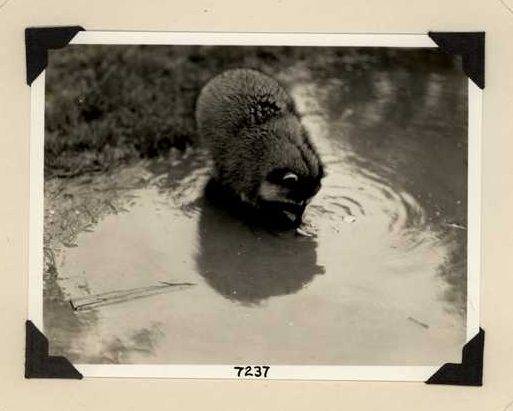Written by URAP Lorena Zeferino, a third year MCB Neurobiology student participating in the IMLS, “Strategic Stewardship for Sustaining the Archives of the Museum of Vertebrate Zoology” project.

Photo taken by L.V. Compton, Point Lobos, Monterey County, California, 1934, MVZ 7238
Ever since I was a young child, I always had a love for animals and while looking through the MVZ archive, I was delighted by L.V Compton’s photographs of California’s adorable little thief; the raccoon. Raccoons are a species that is found commonly throughout Northern California and usually can live in farmlands, urban cities and suburban towns. I am from southern California where the raccoon population is particularly abundant since raccoons are attracted to urban cities such as Los Angeles and suburban areas such as Orange County. L.V Compton’s photographs are extraordinary visual captures of raccoons, since these creatures are nocturnal, they use their distinct black masks as a way to reduce glare that helps them visualize better in the dark therefore photographs of raccoons in daylight is a rare chance. Raccoons are also fiercely independent and are known to depart from their mother just after one year of age and due to their highly adaptive nature, it is very common to find a single raccoon burrowing through the trashcans of someone’s home looking for any meal to fulfill their omnivore diet.

Photo taken by L.V. Compton, Point Lobos, Monterey County, California, 1934, MVZ 7238.
L.V Compton’s photographs show a raccoon concentrating on the water which is a usual behavior for this creature. Although raccoons are known to dig into trash in order to find leftovers to feed on, raccoons use water to wash their found meal to reduce bacteria. It can be inferred that these photographs display this common behavior. Raccoons are a unique species but they are not to be considered to be potential pets since they will exhibit wild nature as well as being a heavy carrier of diseases that can be fatal to humans. These creatures will continue to express their wild nature even after being “tamed” therefore raccoons are to remain the nocturnal animals of the wild however L.V Compton’s photograph can be a slight glance into raccoon’s behavior towards their environment.
